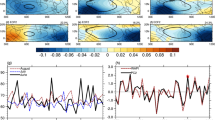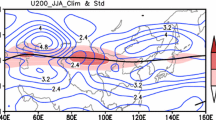Abstract
The interannual meridional displacement of the upper-tropospheric westerly jet over the eastern portion of East Asia in summer has been well documented. This study, however, investigates the interannual meridional displacement of the westerly jet over the western portion of East Asia in summer, which is distinct from its eastern counterpart. The results show that the meridional displacement of the western East Asian jet shows a clear asymmetric feature; that is, there are remarkable differences between the southward and northward displacement of the jet. The southward displacement of the jet corresponds to suppressed convection in the tropical western North Pacific and Maritime Continent and enhanced convection in the equatorial Pacific, which can be explained by the warmer sea surfaces found in the northern Indian Ocean and equatorial eastern Pacific. These tropical anomalies somewhat resemble those associated with the eastern East Asian jet variability. However, the northward displacement of the western East Asian jet does not correspond to significant convection and SST anomalies in the entire tropics; instead, the northward displacement of the jet corresponds well to the positive phase of the Arctic Oscillation. Furthermore, the meridional displacement of the western jet has asymmetric impacts on rainfall and surface air temperatures in East Asia. When the western jet shifts northward, more precipitation is found over South China and Northeast China, and higher temperatures appear in northern China. By contrast, when the jet shifts southward, more precipitation appears over the East Asian rainy belt, including the Yangtze River valley, South Korea, and southern and central Japan and warmer temperatures are found South and Southeast Asia.
摘 要
夏季东亚东部高空西风急流经向位移的年际变化已被广泛研究. 本研究发现东亚西部西风急流与东部急流经向位移的影响因子及气候效应具有显著差异. 东亚西部急流的南移与北印度洋和热带太平洋暖海温异常导致的热带西北太平洋和海洋性大陆对流抑制以及热带太平洋对流增强有关; 而急流的北移并未对应显著的热带海温和对流异常, 其与北极涛动正位相密切相关. 进一步研究发现, 当东亚西部急流偏北时, 中国南部和东北部降水增多, 中国北部地表气温偏高; 而当急流偏南时, 长江流域、 朝鲜半岛南部和日本中南部降水增多, 南亚和东南亚地表气温偏高.
Similar content being viewed by others
References
Adler, R. F., and Coauthors, (2018): The global precipitation climatology project (GPCP) monthly analysis (New Version 2.3) and a review of 2017 global precipitation. Atmosphere, 9, 138, https://doi.org/10.3390/atmos9040138.
Chen, W., and Coauthors, (2016): Variation in summer surface air temperature over Northeast Asia and its associated circulation anomalies. Adv. Atmos. Sci., 33, 1–9, https://doi.org/10.1007/s00376-015-5056-0.
Ding, Y. H., (1992): Summer monsoon rainfalls in China. J. Meteor. Soc. Japan, 70, 373–396, https://doi.org/10.2151/jmsj1965.70.1B_373.
Du, Y., T. M. Li, Z. Q. Xie, and Z. W. Zhu, (2016): Interannual variability of the Asian subtropical westerly jet in boreal summer and associated with circulation and SST anomalies. Climate Dyn., 46, 2673–2688, https://doi.org/10.1007/s00382-015-2723-x.
Harris, I., P. D. Jones, T. J. Osborn, and D. H. Lister, (2014): Updated high-resolution grids of monthly climatic observations-the CRU TS3.10 dataset. International Journal of Climatology, 34, 623–642, https://doi.org/10.1002/joc.3711.
Hersbach, H., and Coauthors, (2020): The ERA5 global reanalysis. Quart. J. Roy. Meteor. Soc., 146, 1999–2049, https://doi.org/10.1002/qj.3803.
Hong, X. W., and R. Y. Lu, (2016): The meridional displacement of the summer Asian jet, Silk Road pattern, and tropical SST anomalies. J. Climate, 29, 3753–3766, https://doi.org/10.1175/JCLI-D-15-0541.1.
Huang, B. Y., and Coauthors, (2017): Extended reconstructed sea surface temperature, version 5 (ERSSTv5): Upgrades, validations, and intercomparisons. J. Climate, 30, 8179–8205, https://doi.org/10.1175/JCLI-D-16-0836.1.
Huang, D. Q., J. Zhu, Y. C. Zhang, and A. N. Huang, (2014): The different configurations of the East Asian polar front jet and subtropical jet and the associated rainfall anomalies over eastern China in summer. J. Climate, 27, 8205–8220, https://doi.org/10.1175/JCLI-D-14-00067.1.
Huang, R. H., and F. Y. Sun, (1992): Impacts of the tropical western Pacific on the East Asian summer monsoon. J. Meteor. Soc. Japan, 70, 243–256, https://doi.org/10.2151/jmsj1965.70.1B_243.
Huang, R. H., L. T. Zhou, and W. Chen, (2003): The progresses of recent studies on the variabilities of the East Asian monsoon and their causes. Adv. Atmos. Sci., 20, 55–69, https://doi.org/10.1007/BF03342050.
Kosaka, Y., and H. Nakamura, (2006): Structure and dynamics of the summertime Pacific-Japan teleconnection pattern. Quart. J. Roy. Meteor. Soc., 132, 2009–2030, https://doi.org/10.1256/qj.05.204.
Kosaka, Y., S. P. Xie, and H. Nakamura, (2011): Dynamics of inter-annual variability in summer precipitation over East Asia. J. Climate, 24, 5435–5453, https://doi.org/10.1175/2011JCLI4099.1.
Kuang, X. Y., and Y. C. Zhang, (2006): Impact of the position abnormalities of East Asian subtropical westerly jet on summer precipitation in middle-lower reaches of Yangtze River. Plateau Meteorology, 25, 382–389, https://doi.org/10.3321/j.issn:1000-0534.2006.03.004. (in Chinese with English abstract)
Kurihara, K., and T. Tsuyuki, (1987): Development of the barotropic high around Japan and its association with Rossby wave-like propagations over the North Pacific: Analysis of August 1984. J. Meteor. Soc. Japan, 65, 237–246, https://doi.org/10.2151/jmsj1965.65.2_237.
Lau, K. M., K. M. Kim, and S. Yang, (2000): Dynamical and boundary forcing characteristics of regional components of the Asian summer monsoon. J. Climate, 13, 2461–2482, https://doi.org/10.1175/1520-0442(2000)013<2461:DABFCO>2.0.CO;2.
Lee, H. T., A. Gruber, R. G. Ellingson, and I. Laszlo, (2007): Development of the HIRS outgoing longwave radiation climate dataset. J. Atmos. Oceanic Technol., 24, 2029–2047, https://doi.org/10.1175/2007JTECHA989.1.
Li, C. F., and Z. D. Lin, (2015): Predictability of the summer East Asian upper-tropospheric westerly jet in ENSEMBLES multi-model forecasts. Adv. Atmos. Sci., 32, 1669–1682, https://doi.org/10.1007/s00376-015-5057-z.
Li, X. Y., and R. Y. Lu, (2017): Extratropical factors affecting the variability in summer precipitation over the Yangtze River basin, China. J. Climate, 30, 8357–8374, https://doi.org/10.1175/JCLI-D-16-0282.1.
Liang, J., Y. Y. Yong, and M. K. Hawcroft, 2022: Long-term trends in atmospheric rivers over East Asia. Climate Dyn., https://doi.org/10.1007/s00382-022-06339-5. https://doi.org/10.1007/s00382-022-06339-5.
Liang, X. Z., and W. C. Wang, (1998): Associations between China monsoon rainfall and tropospheric jets. Quart. J. Roy. Meteor. Soc., 124, 2597–2623, https://doi.org/10.1002/qj.49712455204.
Lin, Z. D., (2010): Relationship between meridional displacement of the monthly East Asian jet stream in the summer and sea surface temperature in the tropical central and eastern Pacific. Atmospheric and Oceanic Science Letters, 3, 40–44, https://doi.org/10.1080/16742834.2010.11446840.
Lin, Z. D., and R. Y. Lu, (2005): Interannual meridional displacement of the East Asian upper-tropospheric jet stream in summer. Adv. Atmos. Sci., 22, 199–211, https://doi.org/10.1007/BF02918509.
Lin, Z. D., R. Y. Lu, and W. Zhou, (2010): Change in early-summer meridional teleconnection over the western North Pacific and East Asia around the late 1970s. International Journal of Climatology, 30, 2195–2204, https://doi.org/10.1002/joc.2038.
Ling, S. N., and R. Y. Lu, (2022): Tropical cyclones over the western North Pacific strengthen the East Asia—Pacific pattern during summer. Adv. Atmos. Sci., 39, 249–259, https://doi.org/10.1007/s00376-021-1171-2.
Lu, R. Y., (2001): Atmospheric circulations and sea surface temperatures related to the convection over the western Pacific warm pool on the interannual scale. Adv. Atmos. Sci., 18, 270–282, https://doi.org/10.1007/s00376-001-0019-z.
Lu, R. Y., (2004): Associations among the components of the East Asian summer monsoon system in the meridional direction. J. Meteor. Soc. Japan, 82, 155–165, https://doi.org/10.2151/jmsj.82.155.
Lu, R. Y., (2005): Interannual variation of North China rainfall in rainy season and SSTs in the equatorial eastern Pacific. Chinese Science Bulletin, 50, 2069–2073, https://doi.org/10.1360/04wd0271.
Lu, R. Y., X. W. Hong, and X. Y. Li, (2016): Asymmetric association of rainfall and atmospheric circulation over East Asia with anomalous rainfall in the tropical western North Pacific in summer. Atmospheric and Oceanic Science Letters, 9, 185–190, https://doi.org/10.1080/16742834.2016.1161489.
Nitta, T., (1987): Convective activities in the tropical western Pacific and their impact on the Northern Hemisphere summer circulation. J. Meteor. Soc. Japan, 65, 373–390, https://doi.org/10.2151/jmsj1965.65.3_373.
Ogi, M., S. Rysgaard, and D. G. Barber, (2016): Importance of combined winter and summer Arctic Oscillation (AO) on September sea ice extent. Environmental Research Letters, 11, 034019, https://doi.org/10.1088/1748-9326/11/3/034019.
Qu, X., and G. Huang, (2012): Impacts of tropical Indian Ocean SST on the meridional displacement of East Asian jet in boreal summer. International Journal of Climatology, 32, 2073–2080, https://doi.org/10.1002/joc.2378.
Tao, S. Y., and L. X. Chen, 1987: A review of recent research on the East Asian summer monsoon in China. Monsoon Meteorology, C. P. Chang and T. N. Krishnamurti, Eds., Oxford University Press, 60–92.
Thompson, D. W. J., and J. M. Wallace, (1998): The Arctic oscillation signature in the wintertime geopotential height and temperature fields. Geophys. Res. Lett., 25, 1297–1300, https://doi.org/10.1029/98GL00950.
Wang, B., R. G. Wu, and K. M. Lau, (2001): Interannual variability of the Asian summer monsoon: Contrasts between the indian and the western North Pacific-East Asian monsoons. J. Climate, 14, 4073–4090, https://doi.org/10.1175/1520-0442(2001)014<4073:IVOTAS>2.0.CO;2.
Wang, M. R., J. Wang, A. M. Duan, Y. M. Liu, and S. W. Zhou, (2018a). Coupling of the quasi-biweekly oscillation of the Tibetan Plateau summer monsoon with the Arctic oscillation. Geophys. Res. Lett., 45, 7756–7764, https://doi.org/10.1029/2018GL077136.
Wang, S. X., H. C. Zuo, S. M. Zhao, J. K. Zhang, and S. Lu, (2018b). How East Asian westerly jet’s meridional position affects the summer rainfall in Yangtze-Huaihe River Valley? Climate Dyn., 51, 4109–4121, https://doi.org/10.1007/s00382-017-3591-3.
Wu, R., and B. Wang, (2001): Multi-stage onset of the summer monsoon over the western North Pacific. Climate Dyn., 17, 277–289, https://doi.org/10.1007/s003820000118.
Xuan, S. L., Q. Y. Zhang, and S. Q. Sun, (2011): Anomalous mid-summer rainfall in Yangtze River-Huaihe River valleys and its association with the East Asia westerly jet. Adv. Atmos. Sci., 28, 387–397, https://doi.org/10.1007/s00376-010-0111-3.
Yan, Z. B., Z. H. Lin, and H. Zhang, (2014): The relationship between the East Asian subtropical westerly jet and summer precipitation over East Asia as simulated by the IAP AGCM4.0. Atmospheric and Oceanic Science Letters, 7, 487–492, https://doi.org/10.3878/AOSL20140048.
Zhou, B. Q., S. J. Hu, Y. L. He, S. Y. Wang, D. Q. Li, and G. L. Feng, (2022): Quantitative evaluations of subtropical westerly jet simulations over East Asia based on multiple CMIP5 and CMIP6 GCMs. Atmospheric Research, 276, 106257, https://doi.org/10.1016/j.atmosres.2022.106257.
Zhou, S. J., G. Huang, and P. Huang, (2020): Inter-model spread of the changes in the East Asian summer monsoon system in CMIP5/6 models. J. Geophys. Res.: Atmos., 125, 2020JD033016, https://doi.org/10.1029/2020JD033016.
Zhou, Z. Q., S. P. Xie, and R. H. Zhang, (2021): Historic Yangtze flooding of 2020 tied to extreme Indian Ocean conditions. Proceedings of the National Academy of Sciences of the United States of America, 118, e2022255118, https://doi.org/10.1073/pnas.2022255118.
Acknowledgements
This research was supported by the National Natural Science Foundation of China (Grant Nos. 42130504 and 42275031).
Author information
Authors and Affiliations
Corresponding author
Additional information
Article Highlights
• The southward displacement of the western East Asian upper-tropospheric jet is associated with tropical forcing, similar to its eastern counterpart.
• The northward displacement of the western East Asian jet is associated with the Arctic Oscillation but not with tropical forcing.
• The southward and northward displacements of the western East Asian jet have asymmetric impacts on the East Asian climate.
Rights and permissions
About this article
Cite this article
Ling, S., Lu, R., Liu, H. et al. Interannual Meridional Displacement of the Upper-Tropospheric Westerly Jet over Western East Asia in Summer. Adv. Atmos. Sci. 40, 1298–1308 (2023). https://doi.org/10.1007/s00376-022-2279-8
Received:
Revised:
Accepted:
Published:
Issue Date:
DOI: https://doi.org/10.1007/s00376-022-2279-8




